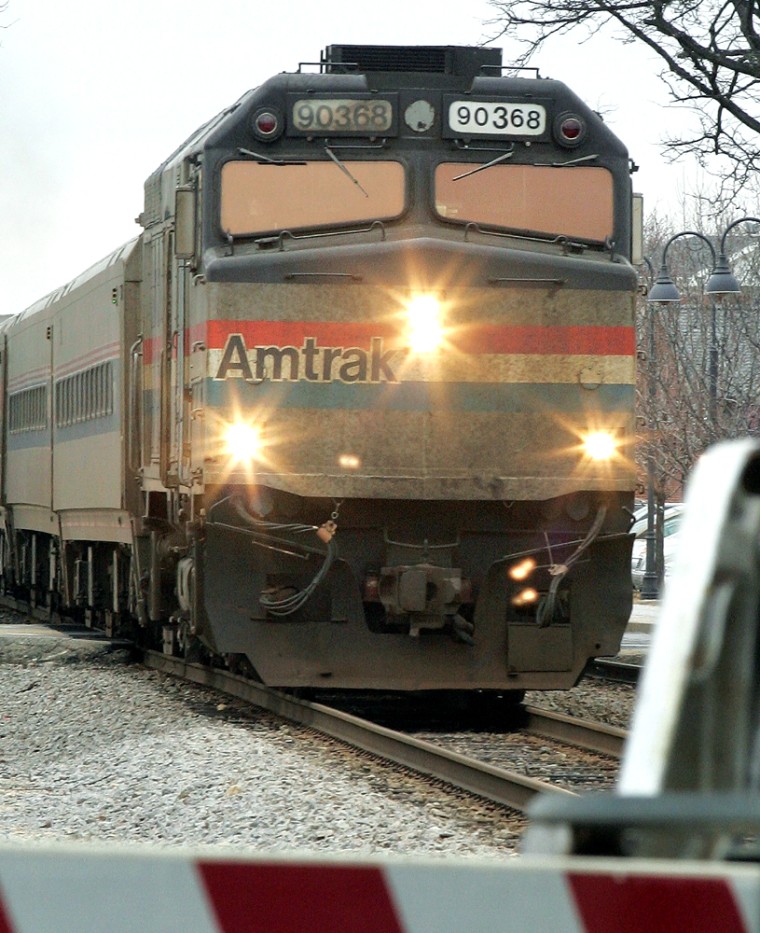If President Bush was trying to send a message to Amtrak with the budget proposal he sent to Congress this week, he certainly succeeded.
Bush’s spending blueprint for fiscal 2006 would reduce Amtrak’s federal subsidy to zero from $1.2 billion, probably sending the company into bankruptcy and possibly spelling the end of passenger service in many of the 46 states now served by the rail carrier.
Amtrak has faced serious threats before, of course. By some accounts the rail line has struggled for survival virtually since Congress created it as the National Railroad Passenger Corp. in 1971.
But the Bush administration’s drastic proposal, coming as part of a broad assault against dozens of federally supported programs, sets up a potential congressional donnybrook over the rail line’s future.
While Amtrak has many advocates in Congress, the fight could bring echoes of last year’s presidential battle, with some of the carrier’s strongest support likely to come from Democratic-leaning, heavily urbanized regions on both coasts that depend most heavily on intercity service.
Bush’s $2.57 trillion budget, of course, is only an opening gambit, and already there are signs the administration is prepared to step back from the brink.
Transportation Secretary Norman Mineta told reporters at a news conference the budget proposal was “a call to action” for Congress to address Amtrak’s problems. “We’ve decided to go to zero to get their attention,” Mineta said.
The budget does include $360 million in contingent funding to keep urban commuter rail service functioning if Amtrak were to go bankrupt. Moody’s Investor Service said bankruptcy would be likely if Congress were to eliminate all federal funding.
Amtrak President David Gunn called the zero-funding proposal “irresponsible and a surprising disappointment.”
“In a word, they have no plan for Amtrak other than bankruptcy,” he said in an e-mail to employees, which was released publicly. “We are committed to an efficient and productive rail passenger system. The plan to force us into bankruptcy would be counterproductive to this goal.”
Amtrak supporters have rallied to the defense of the railroad and are taking nothing for granted.
“This is serious,” said Ross Capon, executive director of the National Association of Rail Passengers, an advocacy group.
“It is tempting to say, of course we are going to win again because having an America without passenger train service is unthinkable,” he said. “But this year you have to look at the number of programs Bush is attacking at once and the extent of those attacks. …. I think we’re going to succeed, but it’s going to be tough.”
Amtrak has long been a favorite target of conservatives who believe the system is a poor use of taxpayer dollars and should be restructured or eliminated.
In the 1980s President Reagan’s budget director David Stockman called Amtrak a “mobile, money-burning machine” and an “amenity that the nation cannot afford and can readily do without.” President Reagan proposed “zeroing out” Amtrak’s subsidy in all eight of the budgets he sent to Congress, according to conservative commentator Paul Weyrich.
Even in signing Amtrak into existence in 1970, President Nixon had to overcome fierce opposition within his administration that was offset by overwhelming congressional support.
“It has struggled ever since it was formed,” said John Spychalski, a transportation expert and professor of supply chain management at Pennsylvania State University.
He said Amtrak has been systematically starved of investment over the years and subject to unrealistic expectations that it could somehow get up on its own feet and become a profitable enterprise. “You cannot operate intercity rail service at a profit,” he said.
Some individual lines may make money “above the rail,” excluding the cost of basic infrastructure and maintenance, but “there is no way those systems as a whole are going to make money on passenger traffic,” he said.
Even in Britain and other European countries where passenger rail service is far more integral to the overall transportation network, privatization efforts have met with mixed results at best.
Robert Poole, a transportation policy expert who has advised the Bush administration, said the time has come to fundamentally rethink the need for passenger rail service in much of the nation.
“Long-distance routes are an endless loss of money,” he said. “They provide so little transportation at so much subsidy per train passenger that they don’t really belong as part of Amtrak.”
He suggests eliminating the long-haul lines, leaving only the more heavily traveled short-haul corridors where the company has a chance to break even on an operating basis.
“If you were able to get states in some of those corridors to offer somewhat more support, and get rid of the long-distance routes altogether, then basically you could operate what remains out of the system without federal subsidies,” said Poole, founder of the Reason Foundation.
Many states would be left without passenger rail service, but “you could also say they would have no horse and buggy service,” he said. “Those people are not cut off from being transported. They have cars, Greyhound, and in many cases they are within 100 miles of an airport.”
He acknowledges that could be a hard sell for lawmakers from the affected states but points out that most Americans probably never set foot on an Amtrak train.
“I think you really have to question the fairness of it,” he said. “I personally love trains. I think trains are really neat, but as a policy researcher I have to say, let’s get real about what is a good use of scarce public funds.”
